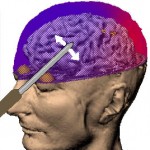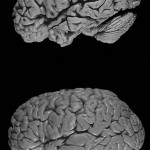q & a
What is lobotomy?
 Lobotomy is a neurosurgical procedure popular in the 1940-50’s but currently used very infrequently. The rationale behind the lobotomy (or “leucotomy”) was to sever the connection between the preforntal cortex and the rest of the brain, but since this was before the advent of neuroimaging (CT or MRI), the doctors really had only a very vague idea of what exactly they were cutting.It was thought that frontal lobotomy could cure psychosis, butthe notion proved to be misguided. Frontal lobotomy “cured”...
Lobotomy is a neurosurgical procedure popular in the 1940-50’s but currently used very infrequently. The rationale behind the lobotomy (or “leucotomy”) was to sever the connection between the preforntal cortex and the rest of the brain, but since this was before the advent of neuroimaging (CT or MRI), the doctors really had only a very vague idea of what exactly they were cutting.It was thought that frontal lobotomy could cure psychosis, butthe notion proved to be misguided. Frontal lobotomy “cured”...Click here to read
Is schizophrenia a brain disease or is it psychodynamic?
 It is important to realize that schizophrenia may takeseveral forms and may have several causations. So it is increasingly common to think of “schizophrenias” rather than of “schizophrenia,” and to regard them as a syndrome or even collection of syndromes rather than as a unitary disorder. Extensive evidence exists and growing thatschizophrenia, orschizophrenias, are caused by brain abnormalities, most likely affecting brain development from very early on, years before the overt symptoms may become apparent
It is important to realize that schizophrenia may takeseveral forms and may have several causations. So it is increasingly common to think of “schizophrenias” rather than of “schizophrenia,” and to regard them as a syndrome or even collection of syndromes rather than as a unitary disorder. Extensive evidence exists and growing thatschizophrenia, orschizophrenias, are caused by brain abnormalities, most likely affecting brain development from very early on, years before the overt symptoms may become apparentClick here to read
What is the Wisconsin Card Sorting Test?
 Wisconsin Card Sorting Test (WCST) is a neuropsychological test designed to evaluate the functions of the frontal lobes. It is commonly used in clinical neuropsychological avaluations and in research. It is important to realize that no single test can fully characterize the function or dysfunction of the frontal lobes (or of any other brain sstructure for that matter). So WCST is veryuseful as part of the assessment but it is not definitive by itself.
Wisconsin Card Sorting Test (WCST) is a neuropsychological test designed to evaluate the functions of the frontal lobes. It is commonly used in clinical neuropsychological avaluations and in research. It is important to realize that no single test can fully characterize the function or dysfunction of the frontal lobes (or of any other brain sstructure for that matter). So WCST is veryuseful as part of the assessment but it is not definitive by itself.Click here to read
Can drugs cure Alzheimer’s disease?
 Unfortunately, no such drugs exist today. Medications are used to treat patient with Alzheimer’s disease and other dementias, but their action is strictly symptomatic and very modest at that. These drugs target various neurotransmitter systems in the brain and tend to have a very modest and transient therapeutic effect on cognition. Most of these drugs target the cholineric or glutaminergic neurotransmitter systems in the brain, by stimulating the former or dampening the latter. But there is a lot of effort...
Unfortunately, no such drugs exist today. Medications are used to treat patient with Alzheimer’s disease and other dementias, but their action is strictly symptomatic and very modest at that. These drugs target various neurotransmitter systems in the brain and tend to have a very modest and transient therapeutic effect on cognition. Most of these drugs target the cholineric or glutaminergic neurotransmitter systems in the brain, by stimulating the former or dampening the latter. But there is a lot of effort...Click here to read
Does HIV affect the brain?
 Yes, it often does. The brain may be affected secondarily, by way of opportunistic infections invading the brain in immunosupressed individuals; and primarily, by way of HIV’s direct impact on the brain. This will result in “HIV encephalopathy” and even in “HIV dementia.”So it is important to pay attention to any cognitive changes in people with HIV. Fortunately, more recent HIV drugs are reasonably good at crossing the “bllod-brain” barrier; as the result both theincidence and severity of cognitive impairment...
Yes, it often does. The brain may be affected secondarily, by way of opportunistic infections invading the brain in immunosupressed individuals; and primarily, by way of HIV’s direct impact on the brain. This will result in “HIV encephalopathy” and even in “HIV dementia.”So it is important to pay attention to any cognitive changes in people with HIV. Fortunately, more recent HIV drugs are reasonably good at crossing the “bllod-brain” barrier; as the result both theincidence and severity of cognitive impairment...Click here to read
What is “agnosia”?
 The term “agnosia” refers to an inability or impaired ability to recognize things through visual, auditory, tactile, or olfacotry inputs, even though the senses themselves are intact. So it is common to think of “agnosias” as impairment of higher-order perception despite tha fact that basic sensory prerequisitesare unaffected. Curiously, the term was introduced by Sigmund Freud, who had a distinguished career in what today would be called “behavioral neurology” before he fathered psychoanalysis.
The term “agnosia” refers to an inability or impaired ability to recognize things through visual, auditory, tactile, or olfacotry inputs, even though the senses themselves are intact. So it is common to think of “agnosias” as impairment of higher-order perception despite tha fact that basic sensory prerequisitesare unaffected. Curiously, the term was introduced by Sigmund Freud, who had a distinguished career in what today would be called “behavioral neurology” before he fathered psychoanalysis.Click here to read
Is language hard-wired?
 Many scientists believe so. Their argument is based on two observations: (a) that all languages have strong similarities, and (b) children acquire language skills very rapidly. Other scientists do not believe that language is hard wired. They would say that all languages are considerably alike because the realities which they describe – those of human habitat – are considerably alike. If deep-sea marine creatures had language it would be radically different from human because their habitat is radically different. As...
Many scientists believe so. Their argument is based on two observations: (a) that all languages have strong similarities, and (b) children acquire language skills very rapidly. Other scientists do not believe that language is hard wired. They would say that all languages are considerably alike because the realities which they describe – those of human habitat – are considerably alike. If deep-sea marine creatures had language it would be radically different from human because their habitat is radically different. As...Click here to read









